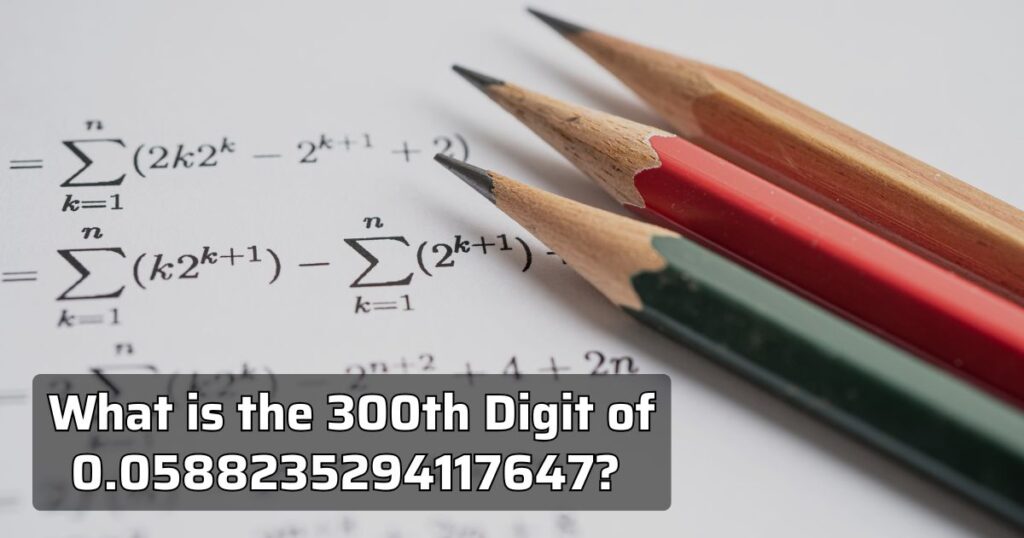Mathematics is filled with fascinating patterns. One such pattern is found in repeating decimals. These are decimals where a group of digits repeats forever. A common question arises: What is the 300th Digit of 0.0588235294117647? While this seems simple, solving it unveils interesting concepts in mathematics. This article will explore repeating decimals, the significance of the 300th digit, and how to find it.
Understanding Repeating Decimals
Repeating decimals occur when a digit or group of digits repeats infinitely. For example, 0.3333… represents the fraction 13\frac{1}{3}31, where the digit 3 repeats indefinitely. The decimal 0.0588235294117647 is another example, with a 16-digit repeating pattern. Recognizing this repetition helps us understand how decimals behave when divided. The concept of repeating decimals is critical in many areas, including number theory, finance, and computer science.
The Decimal Expansion of 0.0588235294117647
The decimal 0.0588235294117647 is a repeating decimal. Its repeating block, “0588235294117647”, continues infinitely. After every 16 digits, the sequence repeats. By recognizing this pattern, we can easily identify any digit in the sequence without writing out the entire decimal. This makes it simple to locate digits like the 100th, 200th, or even the 300th digit.
Identifying the Repeating Pattern in 0.0588235294117647
The repeating block of the decimal is 16 digits long: “0588235294117647”. This pattern repeats over and over again. Once you identify this repeating cycle, you can predict any digit in the sequence. For example, knowing that the block repeats every 16 digits allows us to quickly calculate the position of any digit, including the answer to the question, What is the 300th Digit of 0.0588235294117647? By using this repeating block, we can easily determine the 300th digit without having to write out the entire decimal expansion.
How to Calculate the 300th Digit of 0.0588235294117647
To find the 300th digit, we use simple division. First, divide 300 by 16 (the length of the repeating block):
300÷16=18 remainder 12300 \div 16 = 18 \text{ remainder } 12300÷16=18 remainder 12
The remainder is 12. This means the 300th digit corresponds to the 12th digit in the repeating block. Looking at the repeating block “0588235294117647”, we see that the 12th digit is 4. Thus, the 300th digit of 0.0588235294117647 is 4.
Key Concepts in Decimal Expansion and Repetition
Repeating decimals are important in mathematics. They show the periodic nature of numbers when expressed as decimals. The repeating pattern arises because of remainders during long division. Every time the remainder repeats, the decimal pattern begins again. Understanding these patterns is key to solving problems involving decimals. It also helps to know the length of the repeating block, which can vary depending on the number.
Real-World Applications of Repeating Decimals
Repeating decimals aren’t just theoretical—they have real-world applications. For example, in finance, repeating decimals often appear in interest rates or currency conversion rates. Engineers may encounter repeating decimals when measuring or calculating ratios. Understanding these numbers is crucial for high-precision work. Similarly, computer scientists rely on repeating decimals for algorithms in cryptography and data processing.
Also Read: Ivanka Hrynda Stamford Address
Exploring Other Repeating Decimals and Their Digits
Repeating decimals are common in mathematics. Other examples include 0.3333… for 13\frac{1}{3}31 or 0.142857142857… for 17\frac{1}{7}71. Each of these decimals has a repeating block. The length of the block depends on the fraction being divided. By understanding how the repeating block works, we can calculate specific digits in any repeating decimal. This method can be used for any repeating decimal, regardless of its length.
The Importance of Understanding Specific Digits in Decimals
Knowing how to find specific digits in repeating decimals is more than a fun exercise—it has practical uses. In computer science, algorithms rely on the precision of decimals for encryption and secure communication. In finance, knowing the exact digits of repeating decimals ensures accurate calculations in interest rates or financial modeling. This ability to predict specific digits makes repeating decimals an essential concept in many fields.
Conclusion
The 300th digit of 0.0588235294117647 is 4, and finding it is easier than it first appears. What is the 300th Digit of 0.0588235294117647? By understanding the repeating pattern of the decimal, we can quickly locate any digit in the sequence. Repeating decimals are more than just a curiosity—they are an important concept in mathematics. From number theory to real-world applications in finance and cryptography, repeating decimals play a vital role in many fields. Understanding how to work with them opens the door to a deeper appreciation of the structure and beauty of mathematics.
